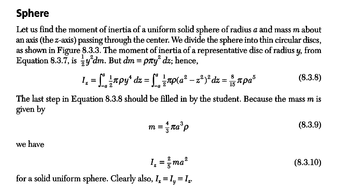Question
could you explain the process of finding Iz for sphere? why do we use the moment of inertia of a flat disk for which dm was p(2pir)dr? Whereas for a sphere dm = p(pir^2)dz , so the element disk here is with volume with thickness dz.

Transcribed Image Text:Sphere
Let us find the moment of inertia of a uniform solid sphere of radius a and mass m about
an axis (the z-axis) passing through the center. We divide the sphere into thin circular discs,
as shown in Figure 8.3.3. The moment of inertia of a representative disc of radius y, from
Equation 8.3.7, isy'dm. But dm = pлy² dz; hence,
2
8
1₂ = Sª ½npy^ dz = [ª ½-¹р(a² − z²)² dz = ³пpa³
-0
(8.3.8)
The last step in Equation 8.3.8 should be filled in by the student. Because the mass m is
given by
we have
m =
nа³p
2
1₂ = ²/ma²
for a solid uniform sphere. Clearly also, I₁ = Iy ³
=
= 1₂
(8.3.9)
(8.3.10)
Expert Solution
This question has been solved!
Explore an expertly crafted, step-by-step solution for a thorough understanding of key concepts.
Step by stepSolved in 2 steps with 1 images

Follow-up Questions
Read through expert solutions to related follow-up questions below.
Follow-up Question
from where there is 1/2 in I expression ? why we multiply by 1/2
Solution
by Bartleby Expert
Follow-up Questions
Read through expert solutions to related follow-up questions below.
Follow-up Question
from where there is 1/2 in I expression ? why we multiply by 1/2
Solution
by Bartleby Expert
Knowledge Booster
Similar questions
- Please obtain the same result as in the book.arrow_forwardLegrende polynomials The amplitude of a stray wave is defined by: SO) =x (21+ 1) exp li8,] sen 8, P(cos 8). INO Here e is the scattering angle, / is the angular momentum and 6, is the phase shift produced by the central potential that performs the scattering. The total cross section is: Show that: 'É4+ 1)sen² 8, .arrow_forward